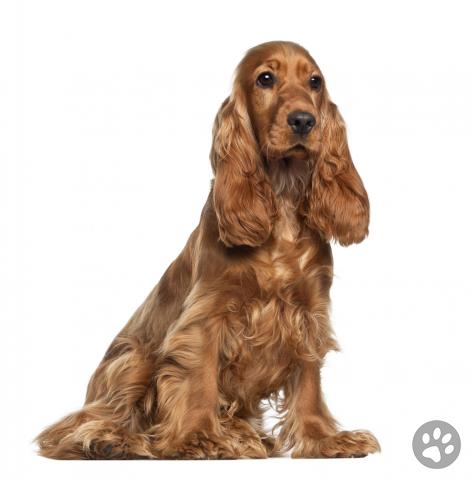Overview
Cocker spaniels were originally bred as hunting dogs in the United Kingdom, and their name comes from their use of hunting woodcock. There are mentions of the breed as early as back in the 14th century. Nowadays, there are two types of Cocker spaniel; the English Cocker Spaniel and the American Cocker Spaniel. Both breeds are commonly referred to as just Cocker Spaniel in their countries of origins. When the breed was first introduced into America in the early 1900s, breeders there preferred a different look and so started to breed physical changes into the Cocker Spaniel. In America, the American Cocker Spaniel is favoured, but in the rest of the world the English Cocker Spaniel is still the more popular.
Breed Characteristics
The Cocker Spaniel is easily recognised by its silky coat, and long, floppy ears. They are known to be lively and friendly, with a tail which is always wagging.
Appearance
The Cocker Spaniel has a medium length coat, soft and silky to the touch, with long feathering on the belly and legs. It can come in a large variety of colours, from the solid black, golden, liver or red; to black and tan; to the roans, roans and tan, and the tricolours or solid colours with more white present. It should be kept clipped around the face and ears, and some prefer to fully clip the whole body in the warmer summer months.
The ears are naturally long and floppy, and should be gathered up at feeding time to ensure they don’t get covered in the dog’s food!
The English Cocker spaniel is slightly taller than long, and slight differences can be found between ‘show’ Cockers, and ‘working’ Cockers. The latter tend to be slightly larger with shorter ears, with a shorter, finer coat which has less feathering.
The American Cocker spaniel tends to be slightly smaller than the English variety, and was bred to have a more ‘stylish’ appearance.
The tail can either be naturally long, tapering to a point, with feathering along the whole length, or in permitted cases, may be ‘docked’ to a short stump.
Size
The English Cocker Spaniel standard height at the wither for males is approximately 15 – 17 inches, with the bitches standing slightly smaller at 14 – 16 inches. Show dogs should have a weight in the range of 13 – 15 kgs.
The American Cocker Spaniel is smaller again, the males’ mature height being about 14 – 16 inches and 13 – 15 inches for the females, with a weight range of 11 – 14 kgs.
Life Expectancy
Cocker Spaniels can live for up to 15 years, with the average lifespan being around 12 – 14 years old.
Personality
The Cocker Spaniel is a fun-loving, highly-energetic, cheerful little dog, who has retained the innate hunting instinct, leading to a keen nose and sometimes selective hearing when out on walks! They have a sensitive nature, so harsh training methods or discipline are not good husbandry. They are easily trained and have a want-to-please nature and should be treated accordingly. They make ideal family dogs and are friendly to everyone, even burglars, so can be good watch dogs, but are no good as guard dogs.
Activity Levels
Having been bred to hunt all day, the Cocker Spaniel is very energetic and needs exercise and space every day to run this energy off. They also love to ‘hunt’ on their walks, with lots of rushing about, nose down. A couple of walks a day being allowed to do just this is normally enough, and an enclosed garden helps too.
Health
Cocker Spaniels are particularly predisposed to Mammary Tumours, with around 30% being malignant, and unless quickly diagnosed and treated can lead to weight loss, pain, and death. Diagnosis is in the form of tissue biopsies, or x-rays, and it is not possible to identify which dogs are carriers, nor reduce the incident of cancer through selective breeding.
Due to their long, floppy ears being low to the ground, Cocker Spaniels are more predisposed to ear infections than other dog breeds. Otitis Externa is an inflammation of the ear canal, and can be caused by a variety of factors, including bacteria, parasites, tumours, or foreign bodies being present in the ear canal. The signs are obvious, with the Spaniel scratching at the ear, or rubbing or shaking the head consistently, often appearing in pain. The ear canal will appear inflamed, sometimes with pus or an odour present, and treatment needs to involve antibiotics.
Familial Nephropathy is an inherited disease, in which young dogs suffer from early-onset kidney failure, and is ultimately fatal to dogs. Early diagnosis is difficult to make but the best method is urine sampling, with a biopsy needed for a definitive diagnosis. DNA testing is available to determine whether the mutated gene responsible is present, and selective breeding is needed so carriers are not used for breeding, proving once again just how important it is to purchase a puppy through a reputable, registered breeder.
The Ideal Owner - Just for fun…!
An energetic family or a cheerful, friendly dog-owner, who enjoy walks through the countryside by themselves whilst their Spaniel rushes here, there and everywhere in the distance, and who wants a lap dog to cuddle up to on the armchair in the evenings, albeit a slightly muddy, smelly one (unless clipped and washed).
Are you a Cocker Spaniel breeder? Please contact us admin@pedigree-pets.com to help expand our knowledge.

